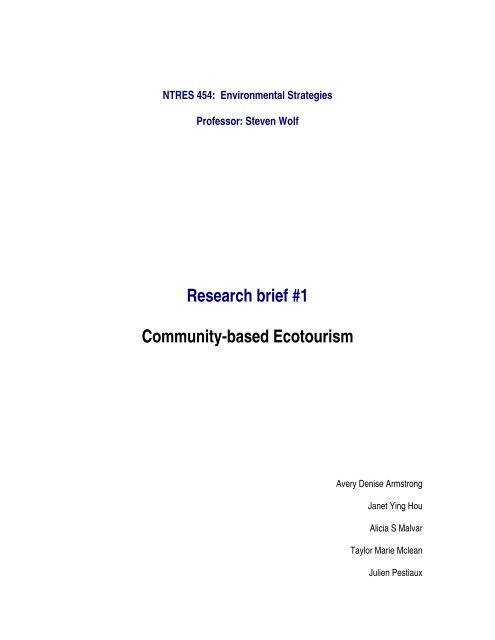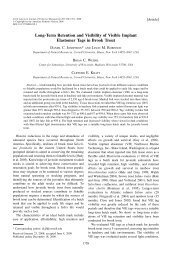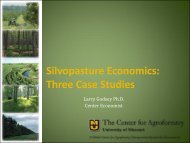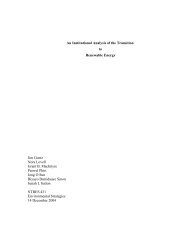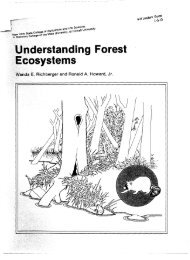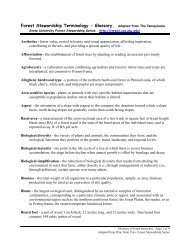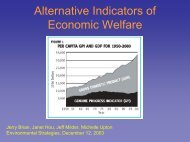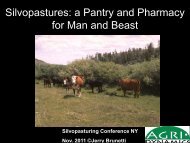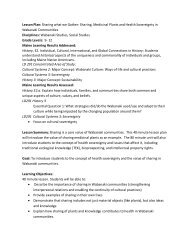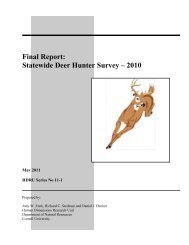Research brief #1 Community-based Ecotourism - Department of ...
Research brief #1 Community-based Ecotourism - Department of ...
Research brief #1 Community-based Ecotourism - Department of ...
You also want an ePaper? Increase the reach of your titles
YUMPU automatically turns print PDFs into web optimized ePapers that Google loves.
NTRES 454: Environmental StrategiesPr<strong>of</strong>essor: Steven Wolf<strong>Research</strong> <strong>brief</strong> <strong>#1</strong><strong>Community</strong>-<strong>based</strong> <strong>Ecotourism</strong>Avery Denise ArmstrongJanet Ying HouAlicia S MalvarTaylor Marie McleanJulien Pestiaux
INTRODUCTION1. DefinitionDefining "<strong>Community</strong>-<strong>based</strong> <strong>Ecotourism</strong>" (CBE) has not proven to be an easy task, giventhe different concepts involved and the different players attempting to define it in terms that arebeneficial to themselves. For the sake <strong>of</strong> clarity we decided to define “community-<strong>based</strong>” and‘”ecotourism” separately.a) <strong>Community</strong>-<strong>based</strong>The idea behind the community-<strong>based</strong> component <strong>of</strong> this Environmental Strategy is tocreate potential for the empowerment <strong>of</strong> the community, enhancing their involvement indecision making, but also simply making sure that the will and incentive to participate comefrom the community itself. This empowerment arises specifically from the control over and theability to manage productive resources in the interest <strong>of</strong> one's own family and community. Itinvokes a basic principle <strong>of</strong> control and accountability which maintains that "the control over anaction should rest with the people who will bear its consequences." 1 This underlies the need forpositive economical/social/environmental benefit for the community. “<strong>Community</strong>-<strong>based</strong> resourcemanagement takes as its point <strong>of</strong> departure, not the bureaucracy and its centrally-mandateddevelopment projects and programs, but rather the community itself: its needs, its capabilities, andultimately its own control over both its resources and its destiny.” 2As is now obvious, the concept evolves around the concept <strong>of</strong> community.1 <strong>Community</strong>-<strong>based</strong> coastal resources Management Philippines Phase I,http://www.eepsea.org/ev.php?ID=3992_201&ID2=DO_TOPIC2 <strong>Community</strong>-<strong>based</strong> coastal resources Management Philippines Phase I,http://www.eepsea.org/ev.php?ID=3992_201&ID2=DO_TOPIC2
CB-CRM [<strong>Community</strong>-<strong>based</strong> coastal resource management] is people-centered,community-oriented and resource-<strong>based</strong>. It starts from the basic premise that peoplehave the innate capacity to understand and act on their own problems. It beginswhere the people are i.e. what the people already know, and build on this knowledgeto develop further their knowledge and create a new consciousness. It strives formore active people's participation in the planning, implementation and evaluation <strong>of</strong>resource management programs. It involves an iterative process where the communitytakes responsibility for the assessment and monitoring <strong>of</strong> environmental conditions andresources and the enforcement <strong>of</strong> agreements and laws. Since the community is involvedin the formulation and implementation <strong>of</strong> management measures a higher degree <strong>of</strong>acceptability and compliance can be expected. 3<strong>Community</strong>-<strong>based</strong> approaches allow each community to develop a management strategywhich meets its own particular needs and conditions, enabling more flexibility. This approach alsoenhances recognition <strong>of</strong> and respect for cultural differences on the local and regional levels andamong nations. It strives to make maximum use <strong>of</strong> indigenous knowledge and experiences indeveloping management strategies.b) <strong>Ecotourism</strong>Tourism represents a huge market in the global sphere. In 2002, the number <strong>of</strong>international tourist arrivals went up to as much as 702.6 millions and is projected to reach over1.56 billion by 2020. This represents about US$ 474.2 billions in receipts at an international scale. 4However, ecotourism represents a very small part <strong>of</strong> this market. “<strong>Ecotourism</strong> represents a smallsegment <strong>of</strong> nature-tourism. Nature-tourism is understood as travel to relatively undisturbed oruncontaminated natural areas and constitutes about 15% <strong>of</strong> all tourism (WWF, 1995).” 5 Thisbranch <strong>of</strong> tourism came up as an answer to the negative characteristics seen in tourism. Indeed,3 <strong>Community</strong>-<strong>based</strong> coastal resources Management Philippines Phase I,http://www.eepsea.org/ev.php?ID=3992_201&ID2=DO_TOPIC4 World Tourism Organization (WTO): http://www.world-tourism.org/5 Gossling Stefan, <strong>Ecotourism</strong>: A Means to Safeguard Biodiversity and Ecosystem Functions?; EcologicalEconomics, v29, n2 (May 1999): 303-203
[tourism] was <strong>of</strong>ten condemned as “whorism” (Munt and Higinio 1993; Shoman 1994) [and]the industry was seen as elite-controlled and was thought to reinforce patterns <strong>of</strong>international inequality, exploitation, and dependency, and contribute to environmentaldegradation (Britton 1981; Perez 1973/74) 6This encouraged the advent <strong>of</strong> <strong>Ecotourism</strong> defined by the International <strong>Ecotourism</strong> Society as“responsible travel to natural areas that conserves the environment and improves the welfare <strong>of</strong>local people”. <strong>Ecotourism</strong> is said to have many advantages, among those, it is supposed to implythat:[V]isitors respect and express interest in local natural history and culture and where alocal tourist economy builds support for environmental conservation (Boo 1990;Brandon 1996; Lindbergh et al. 1996). Compared with mass or “old” tourism,ecotourism is touted as providing better sectoral linkages, reducing “leakages” <strong>of</strong> benefitsout <strong>of</strong> the country, creating local employment, and fostering sustainable development. 7c) Merging these concepts togetherFigure 1 gives a general overview <strong>of</strong> the different concepts merged onto a single triangle.The 3 sides each represent one aspect <strong>of</strong> CBE, with community-<strong>based</strong> at the bottom, providing abase for this Environmental Strategy. This will be a recurrent theme throughout this work andunderlies the importance <strong>of</strong> communities in processes meant to improve their quality <strong>of</strong> life and thequality <strong>of</strong> their environment. The environmental and the economic aspects are placed at the twocorners at the top <strong>of</strong> the triangle: they must balance each other out for this strategy to workeffectively.6 Belsky, Jill M., Misrepresenting Communities : The Politics <strong>of</strong> <strong>Community</strong>-Based Rural <strong>Ecotourism</strong> inGales Pont Manatee, Belize; Rural Sociology ; Dec 1999 ; 64, 4 ; PA <strong>Research</strong> II Periodicals pp.641.7 Belsky, Jill M., Misrepresenting Communities : The Politics <strong>of</strong> <strong>Community</strong>-Based Rural <strong>Ecotourism</strong> inGales Pont Manatee, Belize; Rural Sociology ; Dec 1999 ; 64, 4 ; PA <strong>Research</strong> II Periodicals pp.641.4
DefinitionsEcoEnvironmentalTourismEconomic<strong>Community</strong>-<strong>based</strong> <strong>Ecotourism</strong> (CBE):A special kind <strong>of</strong> market integration forrural communities<strong>Community</strong>-<strong>based</strong>SocialFigure 1: The 3 main aspects <strong>of</strong> <strong>Community</strong>-<strong>based</strong> <strong>Ecotourism</strong>5
2. Goals <strong>of</strong> <strong>Ecotourism</strong>As was introduced above, the central idea <strong>of</strong> <strong>Ecotourism</strong> is to combine environmentalprotection and with the need to sustain the livelihood <strong>of</strong> the communities, thus tackling both socialissues and environmental degradation. The effective implementation <strong>of</strong> <strong>Ecotourism</strong> is thought tohave positive influences in all three areas mentioned above: economic, environmental and social.a) Goals <strong>of</strong> CBE: Economic“<strong>Ecotourism</strong> is described here as a special kind <strong>of</strong> market integration for rural communities.Encounters between hosts and guests in ecotourism are transactions that involve more than theexchange <strong>of</strong> money for goods or services; they also involve the trade <strong>of</strong> expectations and ideasabout nature and culture.” 8 Also, when ecotourism is community-<strong>based</strong>, it essentially brings themarket home, and this allows for different ways <strong>of</strong> participating in the market economy withoutnecessarily or irreversibly disrupting normal livelihoods or social relations. For example, parks mustlook to another source <strong>of</strong> revenue that can rival the income from poaching. Indeed, sale <strong>of</strong> someanimal species and their parts has long been a successful way <strong>of</strong> benefiting from wildlife. Demandhas increased and this calls for new ways <strong>of</strong> protection. “Asian pharmacists pay cash —astronomic prices for rhino horn to grind into medicine. Yemeni men lay out more than $1,000 for acarved rhino-horn dagger” (Knox 1990).” 9Tourism has serious potential to counteract this trend. An example comes from the gorilla inRwanda:The mountain gorilla project started with “fewer than 500 visitors...[paying] a total <strong>of</strong> lessthan $2000 to enter the park... [Ten years later,] an average <strong>of</strong> 5000 tourists now comesto the park to see gorillas annually... [V]isitors pay almost $200 each..., thus [generating]nearly $1,000,000 per year in direct park revenues. Furthermore, it is estimated that8 Stronza Amanda Lee, "Because it is ours": <strong>Community</strong>-<strong>based</strong> ecotourism in the Peruvian Amazon,VOLUME 61-08A OF DISSERTATION ABSTRACTS INTERNATIONAL. PAGE 32359 Lash Gail, What is <strong>Community</strong>-Based <strong>Ecotourism</strong>?, The <strong>Ecotourism</strong> Society, Vermont, USAwww.rec<strong>of</strong>tc.org/documents/Inter_Reps/<strong>Ecotourism</strong>/Lash.rtf6
these visitors spend an additional $600 each, or roughly $3,000,000 annually in thecountry... Estimated revenues from all tourist-related sources total $6-8 million per year,moving tourism ahead <strong>of</strong> all but c<strong>of</strong>fee and tea exports as one <strong>of</strong> Rwanda’s principalsources <strong>of</strong> foreign exchange” (Vedder and Weber 1990). 10b) Goals <strong>of</strong> CBE: EnvironmentalBy making the local economy more sustainable ecotourism also gives more support forenvironmental conservation and fosters sustainable development. New management practices canalso encourage the reduction <strong>of</strong> tourist pressure on critical areas. An example <strong>of</strong> this is given byecotourism practices in Costa Rica, where:[A]dmission fees [were raised] by a factor <strong>of</strong> 10 in 1994 (from $1.5 to $15 for foreignvisitors). In consequence, visitor numbers plummeted by an average <strong>of</strong> 44% in thefollowing year (Ratermann, 1997), but total revenues increased substantially. This way, itwas possible to combine the maximization <strong>of</strong> economic benefits and reduce the pressureon ecosystems. Admission fees are a means to keep the number <strong>of</strong> visitors within anecosystem’s carrying capacity (McNeely et al., 1990), or to limit growth rates, so thatplanning, management and control measures are not outpaced by the development(Lindberg, 1991). 11c) Goals <strong>of</strong> CBE: SocialFrom a social perspective, ecotourism is meant to enhance respect and interest in localnatural history and culture, but also to encourage the sharing <strong>of</strong> expectations and ideas aboutnature and culture between tourists and locals. It should also increase local awareness andeducation and provide better linkages between actors in their local environment, such as local<strong>of</strong>ficials, NGOs and communities. As a whole, it relies on both economic and environmental goalsto benefit the communities. It is clear that these benefits will allow this environmental strategy to beeffective. “Look at the rhino from the Zambians’ perspective: here’s an animal walking around with10 Lash Gail, What is <strong>Community</strong>-Based <strong>Ecotourism</strong>?, The <strong>Ecotourism</strong> Society, Vermont, USAwww.rec<strong>of</strong>tc.org/documents/Inter_Reps/<strong>Ecotourism</strong>/Lash.rtf11 Stefan Gössling; <strong>Ecotourism</strong>: a means to safeguard biodiversity and ecosystem functions?; EcologicalEconomics 29 (1999) 303–320.7
thousands <strong>of</strong> dollars on its nose, an animal that doesn’t do anybody any good anyway, except...asan attraction for rich tourists. Should Zambian families starve so tourists can take pictures <strong>of</strong>rhino”? (Knox 1990).” Poor rural communities must be assured an improved standard <strong>of</strong> living fromecotourism, if they are to support the preservation <strong>of</strong> wildlife, the natural habitat, and therefore theecotourism industry.But employment and education can also bring negative social impacts. “Tribal elderstraditionally hold most <strong>of</strong> the knowledge and respect <strong>of</strong> the community. As the younger generationgain jobs and money from tourism, they may also gain prestige that rivals the elders. Their incomefrom ecotourism is frequently many times what a villager makes from traditional means. This canlead to jealousy, and even murder, as in the case <strong>of</strong> a young Malagasy guide who was stoned todeath by his peers (Jolly pers. comm.). Uncontrolled growth <strong>of</strong> tourism and the influx <strong>of</strong> westernvalues can erode the local culture.” 12Another negative impact <strong>of</strong> ecotourism is the increased pressure on the region created bytourism in some areas, even when practised as ecotourism. This includes trash, increased use <strong>of</strong>natural resources, etc. “Higher standards <strong>of</strong> living (a benefit from ecotourism) have attractedmainland Ecuadorians to the Galapagos, producing an uncontrolled growth <strong>of</strong> 12% a year in thelocal population. This creates several problems:resentment <strong>of</strong> “newcomers taking jobs..., shortages <strong>of</strong> basic foods at local shops...[and]raised prices” (Boo 1990). Additional negative social impacts include: begging bychildren; incompatibility <strong>of</strong> local versus foreign customs as female visitors dressinappropriately; social dualism; and growth <strong>of</strong> hostility towards tourists due toexpatriation and overcrowding. Without proper planning and control <strong>of</strong> ecotourism, theattitudes <strong>of</strong> the local inhabitants towards tourism can go from “euphoria to apathy toannoyance to antagonism” (Long 1990). ” 1312 Lash Gail, What is <strong>Community</strong>-Based <strong>Ecotourism</strong>?, The <strong>Ecotourism</strong> Society, Vermont, USAwww.rec<strong>of</strong>tc.org/documents/Inter_Reps/<strong>Ecotourism</strong>/Lash.rtf13 Lash Gail, What is <strong>Community</strong>-Based <strong>Ecotourism</strong>?, The <strong>Ecotourism</strong> Society, Vermont, USAwww.rec<strong>of</strong>tc.org/documents/Inter_Reps/<strong>Ecotourism</strong>/Lash.rtf8
CASE STUDY 1: BAGHMARA COMMUNITY FOREST, NEPALThe Baghmara community forest, located in the Southern plains <strong>of</strong> Nepal is a goodexample <strong>of</strong> how the actions <strong>of</strong> national governments, when combined with support from non-pr<strong>of</strong>itorganizations and the cooperation and participation <strong>of</strong> local peoples, can be effective in promotingconservation ideals while ensuring the well-being <strong>of</strong> the local community.The Baghmara forestplantation makes a strong case for the ability <strong>of</strong> a community to protect and enhance their naturalresources when they benefit directly from them.The Royal Chitwan National Park (RCNP) in Southeast Nepal is home to over 570flowering plant species, 486 species <strong>of</strong> bird, 40 mammal species, 17 species <strong>of</strong> retiles and 68species <strong>of</strong> fish. This biodiversity, as well as the fact that it serves as a habitat for such endangeredspecies such as Bengal tigers, wild elephants, striped hyenas, one-horned rhinos, and freshwaterdolphin, led to its being declared a World Heritage Site by UNESCO in 1983 (Rijal, 1997). Theseattractions combine to make the RCNP a major international tourist destination, which brings inthousands <strong>of</strong> dollars each year.However, this intensive tourism has expanded too rapidly and placed a considerable strainon the ecological integrity <strong>of</strong> the park (BCN). While the number <strong>of</strong> animals in the park hasincreased, their habitat has decreased due to erosion, encroachment, and the succession <strong>of</strong>grasslands by tall grass, shrubs, and tree species. As a result this has caused the wildlife towander outside the park and into the surrounding farmlands in search <strong>of</strong> food thus creatingconflicts between the park and the surrounding community. (Rijal, 1997) Furthermore, the300,000+ Baghmara people living on the outskirts <strong>of</strong> the park rely heavily on fuelwood and fodderharvest from the surrounding forests. Rijal estimates that there is an annual demand for 219,905tons <strong>of</strong> fodder and timber and that only a limited amount <strong>of</strong> this demand can be met by sourcesoutside the community. As a result, local people have turned to the illegal collection <strong>of</strong> fuelwood9
from inside the park, which further threatens biodiversity. This conflict was intensified by the factthat the local population had only a 2% employment rate from the tourist industry. The rest <strong>of</strong> thecommunity received little or no direct benefit from the thriving tourism industry (Rijal, 1997) so theyhad little incentive to conserve and protect the environment <strong>of</strong> the park.In order to tackle these issues, the Nepal Conservation <strong>Research</strong> and Training Center(NCTRC) and the King Mahendra Trust for Nature Conservation (KMTNC) launched a buffer zoneplantation program in 1989. The objective <strong>of</strong> the program was to establish plantations in the bufferzones surrounding the park in order to meet the communities’ fuelwood and fodder needs. A total<strong>of</strong> 81,000 saplings <strong>of</strong> fast growing indigenous tree species such as Dalbergia sissoo and Acaciacatechu were planted over an area <strong>of</strong> 32 ha.The idea was that once the plantation wasestablished, the community forest area could also be opened to ecotourism, thus demonstratingthe potential economic value <strong>of</strong> conservation to the communities surrounding the park.In its first year in operation, the project met with some issues concerning propermanagement <strong>of</strong> the park and suffered from a lack <strong>of</strong> attention from government authorities.However, there was enough support among the local people for the project that it was able to holdon. It was in 1993 when there was a real turning point in the Baghmara project. In this year, theForest Act <strong>of</strong> 1993 was passed by the government establishing Forest User Groups (FUG’s) as“independent organizations allowed to manage forest area for their own use and benefit” (Rijal,1997). When the Baghmara FUG was established it consisted <strong>of</strong> a 19-member committee thatworks to prepare programs for the year.These programs are then presented to the generalcommunity only after unanimous approval by the committee. The Baghmara community groupcame up with its own operational plan to manage the community forest, and receives feedback ingeneral meetings in which one person from each household in the area is required to attend.(Rijal, 1997) The KTMC and the Biodiversity Conservation Network (BCN) also led an effort todraft and pass legislation through the government <strong>of</strong> Nepal whereby 30 to 50 percent <strong>of</strong> the10
evenue earned by tourism taxes would be shared with the local community. Village-<strong>based</strong> usergroups decide the best way to use this extra income in a way that brings the greatest benefit to thecommunity. The result <strong>of</strong> these actions was to give the Baghmara communities incentive topractice conservation through the generation <strong>of</strong> tourist revenue while also giving them control overa sustainable source <strong>of</strong> fuelwood and fodder. This served not only to eliminate the need to gatherwood illegally, thus minimizing pressure on the park, but also to extend the wildlife habitat into thebuffer zone.The Forest User Group continued to expand the plantation area, fencing in 348 ha <strong>of</strong>degraded forest in 1994 to allow for natural regeneration, and subsequently planted small sections<strong>of</strong> this area. The buffer plantation quickly grew to 400 ha <strong>of</strong> mixed plantation, pure plantation,natural regeneration forest, grassland, and lakes (Rijal, 1997). A testament to the effectiveness <strong>of</strong>the project is that the plantation area was <strong>of</strong>ficially handed over by the government to the chairmen<strong>of</strong> the Baghmara community forest on June 15, 1995.The project’s real success lies in the fact that the community is now able to meet all <strong>of</strong> theirfuel and fodder needs in a sustainable way that is completely in their control. Extending the forestinto the buffer zone has also provided a habitat for wildlife. In 1997 there were 15 rhinos livingwithin the community forest area, as well as 104 plant species, over 20 mammal species, and 125avian species. (Khatri, 2001). The area has also served as a buffer to local farmers, in that cropraids have been reduced significantly since the planting <strong>of</strong> the forest. Due to increased tourism,more people are being employed as nature guides, or have opened hotels and guesthouses.Furthermore, the community members have been able to establish some ecotourism microenterprises such as the construction <strong>of</strong> a “machan,” or wildlife-viewing tower, which generatesabout US $8,000 per year. The community has also started some canoe and nature guideprograms. By transferring some <strong>of</strong> the tourism into the buffer zones, pressure is taken <strong>of</strong> the RCNPwithout sacrificing revenue. Employment and revenue generated by tourism has heightened11
awareness in the community about the benefits <strong>of</strong> conservation. With the approximately US$21,000/year that is comes in as tourist revenue the community has invested in many communitydevelopment projects, as well as environmental projects. Since the area is prone to flooding, thecommittee has helped in the construction <strong>of</strong> a series <strong>of</strong> levees on the Budi Rapti River. They havealso supported the development <strong>of</strong> three local schools, and a nature guide-training program foryouths. The FUG has also used the money to hire forest guards and staff to assist with protection.They have also created another aquatic habitat through the construction <strong>of</strong> a mud-filled dam, aswell as set aside several grassland areas to promote greater biodiversity (Rijal, 1997). Anotherproject activity was to conduct a seven-day “green camp” for teaching environmental awareness tolocal youth (BCN).As a result <strong>of</strong> their current needs being met by the community forest, as well as the release<strong>of</strong> some financial pressure on local people, they are able to think about the future <strong>of</strong> the forest aswell. The FUG has plans to initiate a livestock insurance program that will introduce a new breed<strong>of</strong> livestock that will decrease the total number <strong>of</strong> animals and therefore reduce the fodder demand,while increasing production per animal. The insurance program will <strong>of</strong>fer an incentive to shift fromopen grazing to stall-feeding. The committee is also considering the establishment <strong>of</strong> analternative energy program that will decrease fuelwood demand through the construction <strong>of</strong> asustainable biogas plant.As in any other project, there have been some challenges along the way to theestablishment <strong>of</strong> the Baghmara community forest and ecotourism venture. Nonetheless, it servesas a successful example <strong>of</strong> how the interaction and cooperation <strong>of</strong> local communities, nongovernmentalorganizations, and national governments can produce beneficial results. In thiscase, the pro<strong>of</strong> is in the creation <strong>of</strong> sustainable economic incentives to conservation, the promotion<strong>of</strong> local guardianship <strong>of</strong> biodiversity and the resulting increases in wildlife, and wildlife habitat, andthe improved livelihoods <strong>of</strong> 548 local households.12
CASE STUDY 2: OLANGO BIRDS AND SEASCAPE TOUR, THE PHILIPPINESOlango Island is located at the central region <strong>of</strong> the Philippines, 5 kilometers east <strong>of</strong> themajor island <strong>of</strong> Mactan in Cebu. It has a total land area <strong>of</strong> just 10 square kilometers but is home tomore than 20,000 people. The island has insufficient basic infrastructure like water and wastedisposal and seventy-five percent <strong>of</strong> households depend on coastal resources for theirlivelihoods. 14Olango is a low-lying limestone island famous for its wide fringing coral reefs, seagrassbeds, mangroves, and most particularly its extensive intertidal mudflats, which provide habitat tomigratory birds. Fully half <strong>of</strong> Olango is comprised <strong>of</strong> diverse coastal and marine habitats which hasled to part <strong>of</strong> the island being designated as the Olango Island Wildlife Sanctuary, a national birdsanctuary.The southern portion <strong>of</strong> the island is a stopover for “about 60% <strong>of</strong> the 77 species <strong>of</strong>migratory birds that use the East Asian Migratory Flyway (CRMP, 2001). Thousands <strong>of</strong> birdsmigrate every year to and from Siberia, Northern China, and Japan to Australia and vice versa. Anadditional 42 species <strong>of</strong> birds are year round residents <strong>of</strong> the wetland area. 15Like most coral reefs in the region, Olango have been under siege from destructive humanpractices like over fishing and blast/dynamite fishing, as a result, they are not nearly as productiveas their natural potential would permit. Despite the fact that Olango’s 40 square kilometers <strong>of</strong> reefsare in poor condition they still support a fish yield <strong>of</strong> 5 tons per square kilometer. However, fishyields are far below their potential production <strong>of</strong> 15-20 tons per square kilometer. 16For thisreason, in 1992, a 920ha area was <strong>of</strong>ficially declared as the Olango Island Wildlife Sanctuary(OIWS). Thus, in July 1996, Olango (together with other surrounding islets) was chosen to be theexperimental study site for the Coastal Resource Management Project (CRMP), a Philippines-wide14 Burke,Lauretta (WRI), Sellig, Liz (WRI), Spalding, Mark (UNEP-WCMC,Cambridge,UK).”Reefs at Risk inSoutheast Asia”. 200215 English. “Abstract <strong>of</strong> Dissertation on Environmental Education in <strong>Community</strong>-Based Coastal Resource Management:A Case Study <strong>of</strong> Olango, Island, Philippines.” 200216 Ibid 113
project funded by the United States Agency for International Development (USAID) in partnershipwith the Philippine <strong>Department</strong> <strong>of</strong> Environmental and Natural Resources (DENR).The OlangoBirds and Seascape Tour was the resulting development venture and comprises one <strong>of</strong> the threecomponents <strong>of</strong> the Coastal Resource Management Program (CRMP). It was first introducedcommercially in January 1999 and is owned and managed by a fishing community organized by theSuba, Olango <strong>Ecotourism</strong> Cooperative (SOEC).There are three elements that make this project unique. Olango islands coast, seas, reefs,and wildlife.The activities that can be done in the island are provided essentially by itsindigenous natural resources. The Olango eco tour does not only provide environmentalexperiences that can be done in other eco tour projects but it combines education and learning withfun and enjoyment. Bird watching, coastal trek, canoe paddling, snorkeling, swimming and islandhopping are just some <strong>of</strong> the activities that bring the tourists in touch with Nature. The communitythemselves monitor and ensure that all these activities are done with least impact on theenvironment. They <strong>brief</strong> and guide the tourist on appropriate behavior in that natural areas andcommunities they visit. Moreover, there is always a naturalist interpreter/expert on migratory birdswho is around to give quality information to the guests. 17Secondly, the tour promotes and showcases local conservation <strong>of</strong> threatened coastalenvironments and wildlife. 18 “The tour is a theater production. The guide has to be an educator, anentertainer, an advocate <strong>of</strong> environmental values, and an advocator <strong>of</strong> social ethics.” 19 This is howone <strong>of</strong> the staff differentiates the Olango eco tour from other island hopping packages.Thetourists observe the involvement <strong>of</strong> the local community in the environment conservation likewise17 Flores, Monina. “<strong>Ecotourism</strong> for the People, By the People, Of the People.” 1999.18 Ibid 419 English. “Abstract <strong>of</strong> Dissertation on Environmental Education in <strong>Community</strong>-Based Coastal Resource Management:A Case Study <strong>of</strong> Olango, Island, Philippines.” 200214
they are also enjoying the place.It intends to be an educational experience both in culturalexchange and environmental awareness.The interaction with the community is very much integrated in the entire program thatmakes the experience one <strong>of</strong> a kind for the tourist. Aside from the usual activities that they gothrough, there is a section where community members give demonstrations in shell crafting,preparing local delicacies, and fishing. The final interactive activity is a discussion the efforts andchallenges <strong>of</strong> the community-<strong>based</strong> programs. Each community leaders take turn to relate theirefforts in trying to mobilize the community for common causes such as waste management system,abolishing illegal fishing methods and making tourism a sustainable livelihood. Because <strong>of</strong> thepoverty in the community and the lack <strong>of</strong> alternative livelihood, the people are forced to resort toexploitation <strong>of</strong> natural resources in unsustainable ways. The organization shares their stories intheir struggle to respond to this problem through the eco tour. From these presentations, thetourists learn that the valuable and beautiful resources that they are enjoying are under severethreats from destructive human use as well as the challenges the community go through to managetheir coastal resources.They realize that the fee they pay is itself the realization <strong>of</strong> a fishingcommunity’s effort to promote conservation by engaging in a non-extractive form <strong>of</strong> enterprisewhile promoting environmental understanding to visitors.They levy a user fee <strong>of</strong> USD70.00 for non-Filipinos and USD50.00 for Filipinos. 20 This feeintegrates one <strong>of</strong> the goals <strong>of</strong> ecotourism that the revenues at least partially finance the cost <strong>of</strong>protecting natural areas. It is considered expensive and discriminatory <strong>of</strong> budget pack packers andmost Filipinos sightseeing their own country. However, the community justifies the price becausethe package is not only educating their guests about local environmental and conservation issuesbut also they are also financially supporting the community’s efforts. In other cases, the locals alsoaccept additional, voluntary contributions. The revenues and donations are used in either sole20 ibid 5 , p.2515
source <strong>of</strong> funds for the operation <strong>of</strong> a conservation area or program where there are fixed amountor partially contribute to the operational costs <strong>of</strong> the coral farm or to co-finance rehabilitation onnearby reefs or elsewhere in the country. The community justifies the tour fee as more than justisland hopping but a complete and integrated social and cultural experience with lessons insociology, and a testimony to the closeness <strong>of</strong> humans with nature.Thirdly, the project showcases the potential, viability, and benefits <strong>of</strong> communityparticipation in the ownership and operation <strong>of</strong> ecotourism ventures. 21 The active communitycooperation in the conservation and preservation <strong>of</strong> protected areas clearly show the effectiveness<strong>of</strong> ecotourism as a conservation tool. The Olango Tour contributed largely to the community’ssense <strong>of</strong> empowerment. This is exemplified through the community’s growing sense <strong>of</strong> pride intheir achievements, renewed confidence in their ability to reach their goals, acquisition <strong>of</strong> technicalskills, and manifestation <strong>of</strong> enthusiasm and creativeness in their activities. Most <strong>of</strong> the people inthe community who are involved in the program have no previous experience in the tourismindustry. Probably for the first time in their lives, the people feel they are able to contributesomething noble for which they get affirmation from people outside their community. Moreover, theextra income and the new skills they acquire are incentives for the community to participate andinvolve themselves more in the project. These raised their ability to achieve their dreams <strong>of</strong> abetter future for themselves and for their children.Elements <strong>of</strong> <strong>Community</strong>-Based <strong>Ecotourism</strong> in OlangoThere are five elements <strong>of</strong> community-<strong>based</strong> ecotourism that is highly evident in the Olangoenterprise venture.1) <strong>Community</strong>-Based Benefit and Participation21 Flores, Monina. “<strong>Ecotourism</strong> for the People, By the People, Of the People.” 1999.16
The project benefited 55 families in its introductory year. In 1999, 55% <strong>of</strong> gross revenues wentdirectly to the community through salaries and pr<strong>of</strong>it. 22 The tours generate additional employmentin the community like accounting and meal planning which benefit the women in the community.There are also mini tour operators and local travel agents that materialize from the project.Overnight stay is not part <strong>of</strong> the program. This is in line with the environmental capability andcarrying capacity <strong>of</strong> the island. This project is only a supplementary income to the families involvedand there are still a lot <strong>of</strong> families in the island who are without the benefits from the program.2) Contribution to environmental conservation and environmental educationThe environmental education component is part and parcel <strong>of</strong> the ecotour. This increasesthe community’s awareness and skills in learning their resources as well as teaching them to theirguests. The locals themselves become ambassadors <strong>of</strong> the environment. The supplementaryincome gathered from the venture motivates the community to practice non-extractive and nondestructivemeans <strong>of</strong> fishing that protects the coral reefs and other habitats <strong>of</strong> fish and migratorybirds.3) Market competitiveness and accessibilityA successful ecotourism venture relies also on its accessibility to the market. The Olangotour just on its introductory year <strong>of</strong> operation had 33 tour runs with 357 visitors. 31% <strong>of</strong> them wereforeign guests from 17 countries and 69% were domestic travelers from 11 provinces. 23 More than30 international organizations have visited the project. They include PATA, the <strong>Ecotourism</strong>Society, The Nature Conservancy, Conservation International, Japan International Cooperation,Embassy <strong>of</strong> Switzerland, etc. This has also been featured in a number <strong>of</strong> media establishmentslike leading national dailies and magazines and tv programs. It was cited as one <strong>of</strong> 10 “HighlyCommended Honorees” <strong>of</strong> the Conservation International’s 2000 Excellence in <strong>Ecotourism</strong>22 Flores, Monina. “So Far, So Good: Venture Performance and Benefits”. 199923 Flores, Monina. “So Far, So Good: Venture Performance and Benefits”. 199917
Awards. 24 In 2001, the British Airways Tourism for Tomorrow Awards cited the Olango Birds andSeascape Tour as “Best Environmental Experience” Awardee. 254) Promotion <strong>of</strong> local cultureThe showcases <strong>of</strong> the ecotour and the active participation <strong>of</strong> the community promotes thelocal culture <strong>of</strong> the area. Tourists get a complete cultural experience from watching the localsprepare their delicacies, present their talents in shell crafts, and watch the local dances and listento local music.5) Financial ViabilityPart <strong>of</strong> the Coastal Resource Management Plan (CRMP) is focused gathering informationand assessing the value <strong>of</strong> coastal resources. <strong>Research</strong> shows that despite the degradedcondition <strong>of</strong> Olango’s reefs, it is still worth between US$38,300 – US$63,400.00 per squarekilometers annually or US$1.53 million to US$2.54million for all <strong>of</strong> Olango’s reef area, well withinranges previously calculated for Philippine reefs. 26The costs to manage coastal resources inOlango are US$70,000.00 per year. These include resource assessments and monitoring,community organization, education, training, law enforcement, information dissemination, andplanning activities. The benefits though are still more substantial. With an effective managementprogram, it is expected that the annual net revenues <strong>of</strong> Olango Island’s natural resources couldincrease by 60 percent. 27The Olango Birds and Seascape Tour’s growth potential will proportionately increase withthe good management <strong>of</strong> its resources. The beauty and richness <strong>of</strong> the place will sustain itself tobe marketable for tourists. Coupled with community’s efforts and enthusiasm, the tour is anenvironmental strategy that is financial viable and ecologically sustainable.24 Ibid 1025 Ibid 1026 Calumpong,H.P., Estacion, J.S., and Lepiten, M. “Status <strong>of</strong> the Coastal Resources <strong>of</strong> the Olango Learning Site”.1997.27 White, A.T., Ross, M., and Flores, M.”Benefits and Costs <strong>of</strong> Coral Reef and Wetland Management”. 200018
CASE STUDY 3: ESELENKEI CONSERVATION AREAHistory: The Creation <strong>of</strong> Eselenkei Conservation Area 28The Selengei Group Ranch (SGR), located in the Kajiado District <strong>of</strong> Kenya near theAmboseli National Park, is a community <strong>of</strong> approximately 3,000 people. The SGR owns the landon which the Eselenkei Conservation Area exists. During the wet season, the eastern area <strong>of</strong> theland is used extensively by wildebeests, zebras, hyenas, leopards, and lions however the area isbest know for its abundant and diverse bird populations. Before the Eselenkei Conservation Areawas created, The Cheffings Company (a British tourism outfit) with the consent <strong>of</strong> the communityhad been bringing ornithologists and bird hunters into the area since 1920. In 1988 a 20-acrecampsite was built to accommodate the visitors, and fees were charged for hunting and camping.Portions <strong>of</strong> these fees (approximately US$ 925) went to the Selengei Group Ranch (SGR)community as compensation for the use <strong>of</strong> their land. This money was used to build schools andsponsor primary and secondary students for further education.In 1995 a former Amboseli game warden, which had been involved in the bird shootingtourism activities, saw an opportunity for substantial pr<strong>of</strong>its through the creation <strong>of</strong> an ecotourismsite for wildlife and photographic safaris. When he approached the local Maasai chief about settingaside some <strong>of</strong> the dry season grazing area for a sanctuary, he was met with hostility, as thecommunity considered him to be the man that “sold out Amboseli.” They had no interest in hisproposal, even though according to the game warden, “all they have to do is to set aside the landfor wildlife, and sit and watch the money roll in.” The game warden contacted Tropical Places, Ltd.(TPL), a British tour operator, about the venture. TPL agreed there was high potential, and wasbrought in to discuss plans for an ecotourism venture with the SGR.28 Rutten, Marcel. “Parks beyond Parks: Genuine community-<strong>based</strong> wildlife eco-tourism or just anotherloss <strong>of</strong> land for Maasai pastoralists in Kenya?” Issue paper no. 111. 2002. International Institute forEnvironment and Development (IIED).19
The initial plan was to have a 7,000 ha area (approximately 17,200 acres) leased to TPLand kept free <strong>of</strong> livestock, huts, and local hunting. A 60-bed tourist lodge, expected to be filled at60% occupancy rate, was to be built in this reserve area. The initial cost <strong>of</strong> the project wasestimated to be $2 million, which would cover the cost to construct the lodge and other relatedinfrastructure. The potential pr<strong>of</strong>its however were estimated to be in the range <strong>of</strong> $1,650,000 peryear, this would easily justify the initial capital expenditure. Of that money, the SGR couldpotentially expect to receive $96,000 per year after costs. However, TPL said they could onlyguarantee about $4,000 per year (plus an annual rental fee <strong>of</strong> $4,445 for use <strong>of</strong> the land) since the$96,000 was <strong>based</strong> on a prediction <strong>of</strong> a 60% occupancy rate, which could not be guaranteed. Toput these figures in perspective, the average income <strong>of</strong> an individual in the SGR is $10,000, <strong>based</strong>on a herd size <strong>of</strong> 50 cattle (the main source <strong>of</strong> livelihood for the community). Therefore $8,000,once distributed amongst the community, would not make a significant impact to an individualmember’s income. As a result there has, from the beginning, been a lack <strong>of</strong> incentive for thecommunity to view this project as beneficial and wish to see it succeed.Below is the final agreement signed by the community and Porini <strong>Ecotourism</strong>, Ltd., adaughter company <strong>of</strong> TPL, which would be responsible for the management <strong>of</strong> the tourism venture.• 7,000 ha would be leased to Porini to be used for the wildlife conservation area for a period<strong>of</strong> 15 years• 16.2 ha within the leased 7,000 ha would be allowed for a lodge• US$ 4,445 rental fee would be paid to the SGR for use <strong>of</strong> the land each year• Grazing would be allowed in the area during the dry season except where facilities wereconstructed• A 5 km zone would be created around Eselenkei where there would be no wildlife-relatedtourism activities.20
• <strong>Community</strong> members were to be employed by the company both for construction andrunning the camp• The Eselenkei Conservation Area would be open to tourists one year after the signing <strong>of</strong>the agreementA Porini liaison <strong>of</strong>ficer was employed by Porini to facilitate communication between Poriniand the community. However, the liaison was mainly seen as working for Porini and assisting thePorini project manager. This liaison was a member <strong>of</strong> the SGR committee, the governing body forthe group ranch. The SGR then created a community liaison post, for which Porini also paid for,angering the Porini liaison <strong>of</strong>ficer. Tensions mounted within the community as members began tochoose sides between to the two liaisons, and also between the community and the Porinimanager, whom they felt disrespected their community (he had allegedly made negative commentsabout their pastoralist livelihood). As there was no non-governmental organization (NGO) tointervene, and the central government was not very involved, the problems continued to persist.Eventually the SGR chased the manager out, burned some <strong>of</strong> the temporary huts that had beenconstructed, and tore down the Conservation Area sign that had been created in protest. Theproject was halted for 4 months.Clan politics mixed with national politics and quarrel continued within the community as itbecame divided into two factions, the Porini liaison camp and the anti-Porini liaison camp. Amember <strong>of</strong> the local government finally stepped in to mediate the situation, and a new agreementwas drafted to appease the community. In the agreement the number <strong>of</strong> hectares was decreasedto 5,000 and a Conservation Area Committee was created to manage the distribution andexpenditure <strong>of</strong> fees from Porini. Unfortunately, the community issues had not been resolved in thisnew agreement, and eventually it was decided that revenues would be split between theConservation Area Committee and the Group Ranch Committee.21
The tourist camp was completed in 2001 with only 8 beds available as opposed to the 60-bed lodge that was planned. This resulted in significantly decreased revenue due to the reductionin bed space and visitor fees. The actual monetary compensation to the community consisted <strong>of</strong>approximately US$ 8 per person per year, as opposed to the US$ 29 per person per year originallyprojected by TPL. Additionally, the community has lost the benefits generated from the fairlyprosperous bird hunting and tourism, faced reduced grazing land for their cattle, resulting in adecrease in their cattle population and thus income, and there is more game within the area,resulting in livestock loss, disease, competition for water and grazing, and destruction <strong>of</strong> crops. Notin the least, the community, which once was known as “one <strong>of</strong> the most harmonious…inMaasailand” is now splintered and there is a lack <strong>of</strong> trust among members.The tourist operators, however, are making substantial pr<strong>of</strong>its – US$ 156,540 per year ismade for Porini, after the deduction <strong>of</strong> the Selengei payments, costs, and labor.ISSUES:From the beginning this was not a true CBNRM strategy – the key players in any CBNRMstrategy consist <strong>of</strong> the community impacted, NGOs, and the government, be it central or local. TheNGOs and government can provide expertise and act as a means to ensure clear communicationand diffuse any tense situations that hinder the project. SNV Netherlands DevelopmentOrganisation, an NGO that has done substantial work in Kenya, could have been an invaluablesource for the project, having had previous experience in CBNRM and in working with the Maasaiand Kenyans in general. SNV Netherlands also could have acted as the impartial party in resolvingthe problems within and between the community and Porini. 1,29The Kenyan Wildlife Service (KWS) played a minimal role in the process by bringingseveral members <strong>of</strong> the SGR to other group ranch sites where ecotourism has been successful.29 www.snvworld.org. SNV Netherlands Development Organisation homepage.22
The minimized role <strong>of</strong> the KWS is a result from the national policy that directs just when the centralgovernment can become involved in the management <strong>of</strong> natural resources with communities. Withan increased role, the government can provide some institutional capacity to assist the communityin developing the necessary skills for management <strong>of</strong> their natural resources as well as politicaland financial management. 30The Selengei community had to be convinced from the beginning to accept this project,and there were hostile feelings from the start towards the proponents <strong>of</strong> the project (i.e. theAmboseli game warden). Additionally, misaligned interests resulted in poor planning,miscommunication, and mistrust. TPL and Porini were more concerned with getting tourists to thearea and making a pr<strong>of</strong>it – in fact, from the beginning the attitude was the Maasai didn’t have to doanything but watch the money come in. TPL and Porini had immediately delegated a passive roleto the community and did not give the SGR members any reason or incentive to see the venturesucceeded.The pr<strong>of</strong>its relegated to the community, even at the initial projected levels, would not havemade a substantial increase in the average livelihood, and the community had been managing theirlands and wildlife before without any problems. In fact, they were making money <strong>of</strong>f <strong>of</strong> the wildlifewith their bird hunting and viewing arrangement with The Cheffings Company, and keeping theirgrazing and land management rights at the same time. The deal <strong>of</strong>fered by Porini effectively tookaway their management rights and <strong>of</strong>fered no equivalent compensation for that loss. 1Since the community did not have any decision-making authority in the project, they endedup competing against each other for the few jobs that Porini provided through construction and astour guides. The community did not have the opportunity to make keeping what is mine and notsharing, and preferential treatment as far as who receives sure that all members were involved and30 Mburu, John. “Wildlife Conservation and Management in Kenya: Towards a Co-managementApproach.” Center for Development <strong>Research</strong>, University <strong>of</strong> Bonn. August 2003. Paper presented at 4 thBioecon Workshop on the Economics <strong>of</strong> Biodiversity Conservation.23
had a stake in the project. The resulting social tensions aggravated the substandard financialsituation – splitting the revenues between the two organizations makes for very inefficient use <strong>of</strong>funds and there is a mentality <strong>of</strong> how much. 31The social and environmental costs have, so far, outweighed the benefits, which have been fewand far between. As to whether this case meets the environmental goals <strong>of</strong> CBNRM, this ventureis sure to fail. Despite the lower numbers <strong>of</strong> tourists and thus reduced impact on the environment,the lack <strong>of</strong> social and political harmony will have a significant, and detrimental, impact on resourcemanagement. <strong>Community</strong> in-fighting continues and thus poor decisions result from compromisesmade that address politics, as opposed to actual environmental issues. Additionally, the increase inwildlife in such a limited area does not bode well for either wildlife populations or the landscape;there has been an increase in human-wildlife conflict, as leopards kill livestock and crops aregrazed and destroyed by the wildlife, and there has also been increased competition among thepeople, wildlife, and livestock for precious watering holes and food.31 Bassi, Dr. Marco. “Enhancing Equity in the Relationship between protected areas and local communitiesin the context <strong>of</strong> global change: Horn <strong>of</strong> Africa and Kenya.” January 2003. IUCN/CEESP/WCPA.24
CONCLUSION<strong>Ecotourism</strong> is an exciting evolution in the business <strong>of</strong> nature tourism because it addressessocial and economic questions in addition to environmental issues. <strong>Community</strong> Based <strong>Ecotourism</strong>is people centered, community orientated, and resources <strong>based</strong>. By promoting tourism through theprotection <strong>of</strong> the environment, biodiversity is preserved, jobs are created, environmental educationwithin the communities is promoted, and an understanding <strong>of</strong> local peoples and cultures in fosteredamong the tourists who visit these communities.As illustrated in the three case studies, involvement <strong>of</strong> the community is key to the success<strong>of</strong> any CBE venture. During the planning and development stage <strong>of</strong> the project, NGO’s,environmental groups, and government agencies need to work closely with the local peopleinvolved. There must be specific and tangible benefits to the communities impacted, these cantake the form <strong>of</strong> jobs, education, cultural preservation, and environmental protection. <strong>Ecotourism</strong>can help to preserve cultures by halting the outflow <strong>of</strong> people and resources from the communitywhile simultaneously protecting and enhancing the environment.As ecotourism continues to expand there is an increased need for some form <strong>of</strong> industrystandards or certification. A recent study by Protecting Paradise compared in detail ninecertification programs, including ones in Australia, Costa Rica, Canada, Guatemala, TheGalapagos Islands, New Zealand, and Europe. The study concluded that two <strong>of</strong> these ecotourismcertification programs, NEAP (Nature and <strong>Ecotourism</strong> Accreditation Program) in Australia and CST(Certification for Sustainable Tourism) in Costa Rica, <strong>of</strong>fered the strongest models. The study alsodiscussed an initiative, spearheaded by the Rainforest Alliance, to study the feasibility <strong>of</strong> creatingan international accreditation system to license agencies that audit tourism businesses. 32<strong>Ecotourism</strong> and nature tourism certification provide industry, protected area managers,local communities and travelers with an assurance that a certified product is backed by acommitment to best practice ecological sustainability, natural area management and the32 Nature and <strong>Ecotourism</strong> Certification Program, <strong>Ecotourism</strong> Australia,http://www.ecotourism.org.au/neap.asp25
quality ecotourism experiences 33 . The Nature and <strong>Ecotourism</strong> Accreditation Programidentifies the following to be key benefits <strong>of</strong> providing industry certification: 34• Criteria to assist operators in the planning and development <strong>of</strong> their nature tourism and/orecotourism product• A guide to assist operators in implementing the principles <strong>of</strong> ecologically sustainabledevelopment• An opportunity for operators to continually improve performance to a standard recognizedas best practice• A recognized logo for operators to use in their marketing material• A recognized means for protected area managers and travelers to identify genuine naturetourism and ecotourism operators• A tool for protected area managers to encourage improved practices that lead to lessenvironmental impact• A tool to help local communities determine a mix <strong>of</strong> tourism activities that maximizesbenefits and minimizes negative impacts• An essential educational and information tool.NEAP further advocates continued assessment <strong>of</strong> ecotour operations and calls for the reviewand updating <strong>of</strong> certification criteria every three years to reflect emerging best managementpractices . This assures credibility <strong>of</strong> the industry and confidence among travelers. Having acertification system will help to cut down on fraud by “ecotour” companies that makeexaggerated claims concerning benefits to communities and the environment. This will helpensure that the people who benefit the most from ecotourism ventures are the communitiesmost heavily impacted by its activities.33 Nature and <strong>Ecotourism</strong> Certification Program, <strong>Ecotourism</strong> Australia,http://www.ecotourism.org.au/neap.asp34 Nature and <strong>Ecotourism</strong> Certification Program, <strong>Ecotourism</strong> Australia,http://www.ecotourism.org.au/neap.asp26
Appendix: Literature review - Importance <strong>of</strong> collaboration andempowerment <strong>of</strong> the local communityThis section <strong>brief</strong>ly surveys some <strong>of</strong> the existing literature on the subject <strong>of</strong> collaboration with thecommunity, a recurring theme in community-<strong>based</strong> resource management.1) “<strong>Ecotourism</strong> will destroy itself unless it goes beyond <strong>of</strong>fering attractive rural settings todiscontented urban denizens. It must encompass the social dimensions <strong>of</strong> productive organizationand environmental conservation to <strong>of</strong>fer viable livelihoods to the direct producers <strong>of</strong> these services.<strong>Ecotourism</strong> must do more than simply create a series <strong>of</strong> activities to attract visitors. Not only must it<strong>of</strong>fer an opportunity to interact with nature in such a way as to make it possible to preserve orenhance the special qualities <strong>of</strong> the site and its flora and fauna, it must also allow local to be part <strong>of</strong>the a successful strategy for promoting sustainability, it must incorporate other complementaryactivities that produce basic needs for the local population, as well as tourism goods and services.”352) “Concern over the injustice and inefficacy <strong>of</strong> center-imposed natural resourceconservation and development has led many to championing community-<strong>based</strong> natural resourcemanagement (CBNRM) and community-<strong>based</strong> conservation (CBC) (Western and Wright 1994). Butwhile scientists, policy planners, and international conservation organizations increasingly supportCBNRM and CBC, and there are instances <strong>of</strong> very successful programs (Getz et al.1999), somewarn that conservation and development may be compatible only under certain conditions (Krameret al., 1997; Wells 1994). The implications <strong>of</strong> placing community at the center <strong>of</strong> resourcemanagement and development depend largely on the concepts and practices underlying specific35 Barkin, David, Alleviating poverty through ecotourism: promises and reality in the Monarch butterflyreserve <strong>of</strong> Mexico; Environment, Development and Sustainability 5: 371-382, 2003.27
strategies, and the interests those strategies actually serve (Agrawal 1997; Brosius et al. 1998; Li1996).” 36 3) It seems that “in the late 1970s and early 1980s there was a growing awareness that theproblems in development were not simply technological but were also social, political andeconomic and that these could not only be addressed by using different approaches. Equity andparticipation reasserted themselves as basic principles in development programs. (…) They alsoconcluded that participation is necessary although not sufficient condition for achieving projectsuccess. (…) In the few recorded successful initiatives in the Philippines, the ability <strong>of</strong> communitiesto decide on how they manage their resources was critical in ensuring that these communities’interest and participation continued beyond the project’s lifetime. (…) People's participation in themanagement <strong>of</strong> resources also provides a sense <strong>of</strong> ownership over the resource which makes thecommunity far more responsible for long-term sustainability <strong>of</strong> resources. With community-sharedresponsibility for providing adequate resource base for future generations, CB-CRM has greaterpotential for effectiveness and equity.” 374) “When ecotourism is participatory, that is, when local hosts are involved as decisionsmakersas well as employees, ecotourism can be a transforming experience rather than simply aneconomic incentive. For this reason, attention to process in ecotourism (i.e., how and why peopleare participating) is as important as measuring results (i.e., how much people are earning, or howmany locals are employed).” 3836 Belsky, Jill M., Misrepresenting Communities : The Politics <strong>of</strong> <strong>Community</strong>-Based Rural <strong>Ecotourism</strong> inGales Pont Manatee, Belize; Rural Sociology ; Dec 1999 ; 64, 4 ; PA <strong>Research</strong> II Periodicals pp.641.37 <strong>Community</strong>-<strong>based</strong> coastal resources Management Philippines Phase I,http://www.eepsea.org/ev.php?ID=3992_201&ID2=DO_TOPIC38 Stronza Amanda Lee, "Because it is ours": <strong>Community</strong>-<strong>based</strong> ecotourism in the Peruvian Amazon,VOLUME 61-08A OF DISSERTATION ABSTRACTS INTERNATIONAL. PAGE 323528
Also, it is important to realize the many different groups in a community. The next fewquotes mention ‘heterogeneity’ which has indeed an important impact on the wayecotourism will be implemented by communities.5) “Understanding <strong>of</strong> the impacts <strong>of</strong> tourism can be enhanced by paying attention toheterogeneity within local communities, revealing not only who is participating and why, but alsohow different kinds <strong>of</strong> participation lead to different outcomes across individuals and households.” 396) “The politics <strong>of</strong> class, gender, and patronage inequities limit the co-management <strong>of</strong>ecotourism associations, equitable distribution <strong>of</strong> ecotourism income, and support for conservationregulations across the community. Attention to multiple interests and identities within the ruralcommunity and relationships to external actors, political institutions and national policies are criticalto understanding the challenges facing community-<strong>based</strong> conservation in Belize and demonstratedthe relevance <strong>of</strong> such attention elsewhere.” 407) “Recent reviews <strong>of</strong> the community in conservation caution that the analysis <strong>of</strong>community has been uncritical and <strong>based</strong> on historically limited views. Agrawal (1997:36) suggeststhat the literature reveals a widespread preoccupation with a “‘mythic community:’ small,homogeneous groups using locally evolved norms to live with nature harmoniously, managingresources sustainably and equitably.” This conception <strong>of</strong> community relies on the idea <strong>of</strong> unity insameness (e.g., shared geography, identity, and experience) rather than <strong>of</strong> unity <strong>based</strong> ondifference, competition, and resistance (Whitt and Slack 1944). ‘Conservationist imaginings’ <strong>of</strong>community lack dynamic historical understanding <strong>of</strong> particular communities, and instead tend tobounce between two ideal types. Innocent primitive societies in pristine ecosystems (theecologically noble community) or backward, traditional communities despoiling nature in order torespond to the intrusion <strong>of</strong> the market and state (Agrawal 1997)39 Stronza Amanda Lee, "Because it is ours": <strong>Community</strong>-<strong>based</strong> ecotourism in the Peruvian Amazon,VOLUME 61-08A OF DISSERTATION ABSTRACTS INTERNATIONAL. PAGE 323540 Belsky, Jill M., Misrepresenting Communities : The Politics <strong>of</strong> <strong>Community</strong>-Based Rural <strong>Ecotourism</strong> inGales Pont Manatee, Belize; Rural Sociology ; Dec 1999 ; 64, 4 ; PA <strong>Research</strong> II Periodicals pp.641.29
(…) While compelling, CBC/CBNRM as a generic solution to generic problems also carries manyrisks. As Li (n.d.:2) observes, ‘detailed studies <strong>of</strong> the effects <strong>of</strong> laws and policies on particularplaces always indicated that local realities are more complex than the policy model suggest, and<strong>of</strong>ten highlight the problems <strong>of</strong> patronage, class and gender inequities.’ ” 4141 Belsky, Jill M., Misrepresenting Communities : The Politics <strong>of</strong> <strong>Community</strong>-Based Rural <strong>Ecotourism</strong> inGales Pont Manatee, Belize; Rural Sociology ; Dec 1999 ; 64, 4 ; PA <strong>Research</strong> II Periodicals pp.641.30
REFERENCES1) Belsky, Jill M., Misrepresenting Communities : The Politics <strong>of</strong> <strong>Community</strong>-Based Rural<strong>Ecotourism</strong> in Gales Pont Manatee, Belize; Rural Sociology ; Dec 1999 ; 64, 4 ; PA<strong>Research</strong> II Periodicals pp.641.2) Stronza Amanda Lee, "Because it is ours": <strong>Community</strong>-<strong>based</strong> ecotourism in the PeruvianAmazon, VOLUME 61-08A OF DISSERTATION ABSTRACTS INTERNATIONAL. PAGE32353) Stefan Gössling; <strong>Ecotourism</strong>: a means to safeguard biodiversity and ecosystem functions?;Ecological Economics 29 (1999) 303–320.4) Barkin, David, Alleviating poverty through ecotourism: promises and reality in the Monarchbutterfly reserve <strong>of</strong> Mexico; Environment, Development and Sustainability 5: 371-382,2003.5) Trent, Douglas B., Putting the “Eco” in <strong>Ecotourism</strong>, Focus Conservation Fund,http://www.focusconservation.org/article.html.6) <strong>Community</strong>-<strong>based</strong> coastal resources Management Philippines Phase I,http://www.eepsea.org/ev.php?ID=3992_201&ID2=DO_TOPIC7) International Development <strong>Research</strong> Center; http://web.idrc.ca/8) Lash Gail, What is <strong>Community</strong>-Based <strong>Ecotourism</strong>?, The <strong>Ecotourism</strong> Society, Vermont,USA www.rec<strong>of</strong>tc.org/documents/Inter_Reps/<strong>Ecotourism</strong>/Lash.rtf9) Bassi, Dr. Marco, Enhancing Equity in the Relationship between protected areas and localcommunities in the context <strong>of</strong> global change: Horn <strong>of</strong> Africa and Kenya, January 2003.IUCN/CEESP/WCPA.10) Khatri, Top B. “Baghmara <strong>Community</strong> Forest: A community managed ecotourismenterprise.” The World Bank/WBI’s CBNRM initiative.http://srdis.ciesin.columbia.edu/cases/nepal-013.htm11) Mburu, John, Wildlife Conservation and Management in Kenya: Towards a ComanagementApproach, Paper presented at 4 th Bioecon Workshop on the Economics <strong>of</strong>Biodiversity, Conservation Center for Development <strong>Research</strong>, University <strong>of</strong> Bonn. August2003.12) Rutten, Marcel, Parks beyond Parks: Genuine community-<strong>based</strong> wildlife eco-tourism orjust another loss <strong>of</strong> land for Maasai pastoralists in Kenya?, International Institute forEnvironment and Development (IIED), Issue paper no. 111, 2002.31
13) Ngece, Kunga. “<strong>Community</strong> Based <strong>Ecotourism</strong>: What can the people <strong>of</strong> East Africa learnfrom success stories elsewhere? East African <strong>Ecotourism</strong> Development and ConservationConsultants. Nairobi, November 2002. www.ecotourism.8m.net214) Bassi, Dr. Marco. “Enhancing Equity in the Relationship between protected areas and localcommunities in the context <strong>of</strong> global change: Horn <strong>of</strong> Africa and Kenya.” January 2003.IUCN/CEESP/WCPA.15) Porini <strong>Ecotourism</strong> Ltd. Homepage, www.porini.com16) SNV Netherlands Development Organisation homepage, www.snvworld.org17) <strong>Ecotourism</strong> in the Forests/Grasslands <strong>of</strong> Royal Chitwan National Park. BiodiversityConservation Network. http://www.bcnet.org/bsp/bcn/learning/ar96/chitwan2.htm18) Khatri, Top B, Baghmara <strong>Community</strong> Forest: A community managed ecotourismenterprise, The World Bank/WBI’s CBNRM initiative.http://srdis.ciesin.columbia.edu/cases/nepal-013.htm19) Ngece, Kunga, <strong>Community</strong> Based <strong>Ecotourism</strong>: What can the people <strong>of</strong> East Africa learnfrom success stories elsewhere?, East African <strong>Ecotourism</strong> Development and ConservationConsultants, Nairobi, November 2002. www.ecotourism.8m.net220) Rijal, Arun, The Baghmara <strong>Community</strong> Forest: An example <strong>of</strong> linkages betweencommunity forestry and ecotourism, 1997, King Mahendra Trust for Nature/NepalConservation <strong>Research</strong> and Training Center: Chitwan, Nepal.www.rec<strong>of</strong>tc.org/documents/Inter_Reps/<strong>Ecotourism</strong>/Rijal.rtf21) Parras, A.D. et al. “Coastal Resources Management in Olango Island: Challenges andOpportunities.” Tambuli: A Publication <strong>of</strong> Coastal Management Practitioners 4:1-9. 199822) Russ G.R. and Alcala, A.C. “Do Marine Reserves Export Adult Fish Biomass?” Evidencefrom Apo Island, Central Philippines.” Marine Ecology 132: 1-9. 1987.23) White, A.T., Ross,M., and Flores, M. “Benefits and Costs <strong>of</strong> Coral Reef and WetlandManagement, Olango Island, Philippines.” In Collected Essays on the Economics <strong>of</strong> CoralReefs, ed. H. Cesar. Kalmar, Sweden: CORDIO. 200024) White, A.T. and Savana, G.C. “Reef Fish Yield and Nonreef Catch <strong>of</strong> Apo Island.” Negros,Philippines. Asian Marine Biology 4: 67-76. 198725) Calumpong, H.P., Estacion, J.S., and Lepiten,M. “Status <strong>of</strong> the Coastal Resources <strong>of</strong> theOlango Learning Site.” Dumaguete City, Negros Oriental, Philippines: Siliman UniversityMarine Laboratory. 199726) Flores, Monina, So Far, So Good: Venture Performance and Benefits, 1999.27) Flores, Monina, <strong>Ecotourism</strong> for the People, By the People, Of the People, 1999.32
28) Huttche, Carsten M. “Environmental, Economic and Social Benefits and Costs <strong>of</strong><strong>Community</strong>-Based <strong>Ecotourism</strong> on Case Studies from Indonesia and Philippines.”Singapore.29) A Case Study <strong>of</strong> Olango, Island, Philippines, Abstract <strong>of</strong> Dissertation on EnvironmentalEducation in <strong>Community</strong>-Based Coastal Resource Management, 2002.30) Burke,Lauretta (WRI), Sellig, Liz (WRI), Spalding, Mark (UNEP-WCMC,Cambridge,UK).Reefs at Risk in Southeast Asia, 2002.31) Nature and <strong>Ecotourism</strong> Certification Program, <strong>Ecotourism</strong> Australia,http://www.ecotourism.org.au/neap.asp32) English, Peter, The Evolution <strong>of</strong> <strong>Ecotourism</strong>,http://www.tropicalnature.org/evolution.htm33) Pleumarom, Anita, Eco-Tourism or Eco-Terrorism?http://www.untamedpath.com/<strong>Ecotourism</strong>/ecoterrorism.html34) Shores, John, The Challenge <strong>of</strong> <strong>Ecotourism</strong>: A Call for Higher Standards,http://www.geocities.com/shores_system/ecot/challenge.html33


